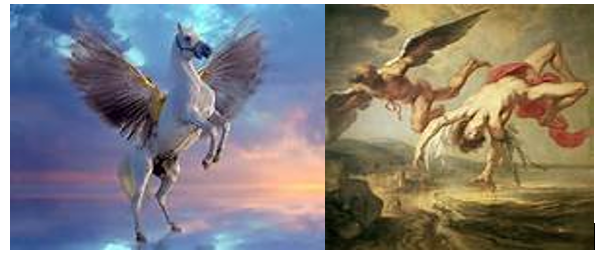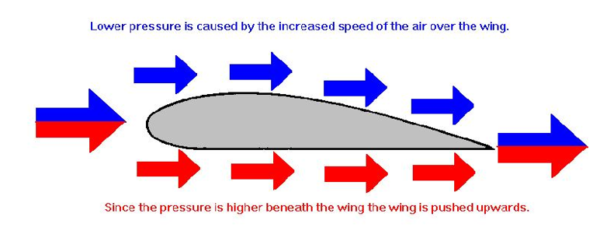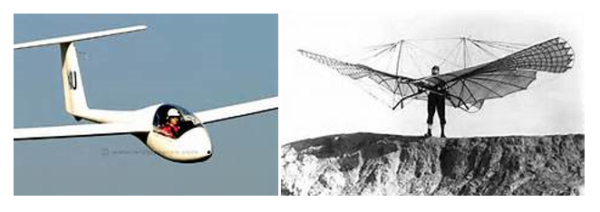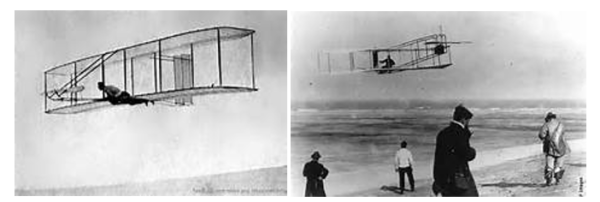A Compilation of the Advent of Flight. – By Group Captain Noor Rahim (RCyAF – Retd.)
 As Homo sapiens became wiser and started using their faculty of thinking – their brain; they made one of the greatest discoveries in the form of the “wheel”. They soon mastered the use of the wheel; and ground transportation was made easier, faster and much more comfortable than riding on animals and being carried in palanquins as hitherto practiced. In the meantime he had used the waterways for transportation by the use of rafts, boats, barges etc. Thus he had experienced and succeeded travelling in 2 dimensions – Length and breadth of the land. Not satisfied with this man also turned his mind towards imitating the birds and thereby making use of the medium of air for recreation and transportation. Thereby the concept of conquering the third dimension (Space) was born.
As Homo sapiens became wiser and started using their faculty of thinking – their brain; they made one of the greatest discoveries in the form of the “wheel”. They soon mastered the use of the wheel; and ground transportation was made easier, faster and much more comfortable than riding on animals and being carried in palanquins as hitherto practiced. In the meantime he had used the waterways for transportation by the use of rafts, boats, barges etc. Thus he had experienced and succeeded travelling in 2 dimensions – Length and breadth of the land. Not satisfied with this man also turned his mind towards imitating the birds and thereby making use of the medium of air for recreation and transportation. Thereby the concept of conquering the third dimension (Space) was born.

We will never be able to say exactly when the idea of conquering the use of medium of airspace was conceived. However, we have read of such exploits in mythology and legends; and even through excavations/archeological findings and cave paintings where Gods, Kings and Ancient Heroes are depicted borne aloft by giant birds, winged horses or have worn artificial wings to conquer the air. In ancient times the ability to fly was taken as a sign of sheer invincibility and the possession of supernatural powers. We have of course heard of such legends of Ravana and his flying chariot; and of Hanuman the “Monkey God” and his flying prowess in the classic Indian Mythology tale from the Mahabharata, of Rama and Sita. We have also read of the tales of Mercury and Icarus in Roman and Greek Mythology.

(Fig. above: Hanuman; Flying Chariot in Greek Mythology; Ravana in Flying Chariot)
For centuries man tried to conquer the 3rd dimension, mainly by imitating the birds. Greek Legend has it that Daedalus, the father of Icarus, made wings of wood, branches and wax to escape from Crete. They tried to do so by wearing these “wings” and Icarus in spite of his father’s warnings flew closer to the sun which caused the wax that held the “wings” together to melt and ending the flight with Icarus falling out of the sky. Experiments like that of Icarus almost always ended with disastrous results.

(Fig. above: Pegasus the Flying Horse; Daedalus & son Icarus)
It is a pity that the theories of Leonardo Da Vinci (1452-1519) remained forgotten until 3 centuries after his death; or else mankind could have seen the “conquest of the air” very much earlier. He invented a machine with man powered flapping “wings” called the “Ornithopter”; and was soon to discover that man’s muscle power alone was not sufficient to move the machine. He further advanced on his theories with plans to build a helicopter but this did not bear fruition.

(Fig. above: Da Vinci’s drawing of Helicopter; Drawings of the Ornithopter)
For centuries man saw smoke rising over burning fires; but little did they realize that a simple clue/solution to the possibility of man’s ability to utilize this phenomena to “conquer the air”. It was two brothers (Montgolfier Brothers) Joseph Michael (1740-1810) and Etienne Jacques (1745-1799), owners of a Paper Factory in Annonay near Lyons in France that realized that if they could trap this “gas” into a container it would rise and thus “take off”. They considered smoke as a “gas”; little realizing that smoke rises because it is expanded hot air and is therefore lighter than the surrounding air which causes it to rise. The brothers continued in their belief and experimented on small models of “balloons”. On June 04, 1783 they successfully launched their invention having a huge fire to fill the balloon with “hot air” in the presence of a large crowd in Annonay. They followed this by launching a hot air balloon in the presence of King Louis XVI and Marie Antoinette on November 21, 1783 with 2 human beings occupying a wicker basket attached under it. The balloon was manufactured with an impermeable fabric; and the two persons carried aloft were Francois Pilatre de Rozier and Marquis D’Arlendes. Thus man had taken his first meaningful step in conquering the air/space. Meanwhile there was another Frenchman, Jacques Alexandre Cesar Charles (1746-1823), who with the assistance of the Robert Brothers (Anne-Jean Robert & Nicholas-Louis Robert) built a balloon filled with the gas “hydrogen”. The first unmanned hydrogen filled balloon was set aloft on August 23rd, 1783. This followed by the manned balloon, in Paris, piloted by Charles and Nicholas-Louis Robert in December 1783. The balloon reached a height of 1,800 feet and lasted 2 hours and 5 minutes covering a distance of 36 kilometers. Charles named his balloon “Charliere”. However it is worthwhile mentioning that 17 years earlier than these history making flights, the discovery of the gas “hydrogen” was discovered by an English scientist as “inflammable air”. It was a French Scientist Lavoisier that named this new founded gas as “HYDROGEN”. This gas being lighter than the surrounding air was an excellent substitute for warm air. Hence we saw its successful use in Charles’ balloons.

(Fig. above: Montgolfier Balloon filled with hot air and “in Flight”; “Charliere” hydrogen filled balloon.)
Very soon after, the Balloon became a rage and passion amongst enthusiasts and pleasure seekers. Furthermore its uses spread into the Military sphere of battles wherein they were used as vehicles for observer missions. However their uses were very limited as they were open to the vagaries of climate and climate changes. In addition they were vulnerable to small arm fire. They were though successfully used in the Franco-Prussian wars of 1870 and during the American Civil War. Due to these short-comings efforts were made to strengthen the balloons; from the collapsible type of balloons to rigid balloons, including steering mechanisms. These improvements culminated with the addition of steam driven engines, capable of driving propellers, to provide propulsion to the balloons. Aerodynamic shapes to the balloons also followed in its footstep. The newly constructed balloons (with a propulsion system) were called “DIRIGIBLE AIRSHIPS”. The airship is in other words a power driven balloon having a streamlined (aero dynamic) shape.
A pioneer in the field of airships was a German – Count Ferdinand Von Zeppelin (1838-1917). His first airship was built in the year 1900; and named after himself –The Zeppelin. A large number of his airships were utilized by the Germans in World War 1. Used primarily in the “frontline” and also in the bombing of cities in and around London. The British and Americans too did deploy .
airships but not to the extent as the Germans. However the usefulness of the airship in battle was short lived due to its vulnerability; and thus saw the cessation of its productions. The airship in the modern day is virtual used for advertising purposes and is also called a “BLIMP”.

(Fig. above: A Zeppelin; A Zeppelin on fire; A “Blimp” of modern time)
It was not until the late 18th century and the beginning of the 19th century that man became conscious of the scientific theories and experiments that were to assist in the conquest of flight. Among those theories were that substances and gases lighter than air tends to rise; that air exerts pressure against all surfaces; and that for every action there is an equal and opposite reaction (Isaac Newton’s theory). The most important theory in the context of Flight was attributed to a Swiss mathematician – Jacques Bernoulli. His mathematical discovery that any fluid flowing over a surface lessens the pressure at the point/s it passes over the surface; and hence the faster it traverses over the surface the lesser will be the pressure at that point. The resultant of this discovery is in aviation jargon called “lift”. This discovery is a vital a principle of Aviation known as the “Bernoulli’s Principle” – that is well known to the Aviator and the Aviation Industry.

(Fig. above: Bernoulli’s Principle) Page 6.
The first concepts of the building of a heavier-than-air craft emerged from the theories put forward by a British pioneer in Aeronautics, Sir George Cayley (1773-1857). In 1804 he built the first model of a glider. Most of his writings and theories were considered very advanced for his time. Had there been a gas powered engine invented at that time it would have most probably been that a powered heavier-than-air machine could have first been flown in England.
Another pioneer in the field of gliders was a German Engineer and Inventor Otto Lilienthal (1848-1896). He entered the aeronautical field in 1889 with the publication on “Bird Flight as the basis of Aviation”. He applied his engineering knowledge and theories on the construction of numerous gliders. He personally “test flew” his inventions from a conical hill that he had constructed. After many successful attempts he managed to cover a distance of over 800 feet. This was most creditable as he had to launch the craft by running with it in order to glide down the hill. Although he was convinced that the secret in flying was to imitate the “birds”; he later converted to the principle of the fixed wing and planned to equip one of his gliders with an engine. Unfortunately this was not to be; as he crashed on one of his many flights, on August 9, 1896, from a height of 50 feet at Rhinow, near Stollen and succumbed to his injuries the next day. Lilienthal is credited for making over 2000 flights.

(Fig. above: Otto Lilienthal Gliders}
The art of using air currents to fly these “heavier-than-air” craft was called “gliding” and the craft was called “gliders”. In fact gliding involved the gradual loss of height to maintain continuous flight of the “glider”. In later years man also improved on the “glider” to enable him to soar in the sky utilizing air rising up mountainsides; and also warm air rising above the ground that is heated by the sun. These were known as “sail planes”. Gliders and sail planes were launched into the sky with the use of catapults or winches which would raise the craft similar to the flying of kites; and was also towed to height by an engine driven aircraft.

(Fig. above: Modern Glider; Lilienthal launching his glider)
The experiments and successes achieved in the field of gliders, by Lilienthal was the inspiration to the Wright Brothers of the United States of America. When news reached them of the untimely death of Lilienthal they decided to devote their time and money to pursue their passion for flying. The Wright Brothers, Orville (1871-1948) and Wilbur (1867-1912), were small businessmen, proud of their bicycle shop in Daytona, U.S.A. They are credited with the successful “flight of a heavier-than-air” craft; which was flown by Wilbur at Kittyhawk N.C on December17, 1903. The craft was powered by a 4 cylinder petrol engine with an output of 12 horse power and named it “Flyer” which was the name of the bicycle manufactured by them. The engine was built by one of their assistants named Charles Taylor, who took approximately 6 weeks to build this light weight petrol driven engine. But in this most historic event he remained an unsung hero.

(Fig. above: Wilbur Wright’s First Flight) Page 8.
The Wright Brothers always meant the airplane to be a contribution to International Communications, Commerce and Goodwill. But apart from fulfilling these roles it was later to become one of the primary weapons in waging war. However, it must be said that without the vast military spending for development the airplane would have never become a safe/or usable vehicle. This continues to date and one foresees its continuity.
With the passage of time the improvements on aircraft improved in leaps and bounds. From fabric covered aircraft to all metal aircraft.
From the small petrol driven engine of the “Flyer”, the aircraft engines improved immensely. This enabled aircraft to be of immense size; with heavy lift capability. It also provided the ability of aircraft flying longer distances and at high speed. With the entry of the “Jet Engine” aircraft were able to fly at higher altitudes and with enhanced performance. Rocket engines too had its earlier use during World War2. These powered the V1 & V2 “flying bombs” used by the Germans. This technology is used in the conquest of outer space by various space agencies in the world today. Presently used in experimental and a few commercial ventures and no doubt is a fore-runner to regular space travel in the future.

(Fig. above: Piston engine; Jet engine; German war time rocket propelled V1 & V2)
POST SCRIPT.
This compilation was done for my son attending the final year of the General Certificate of Education at Maris Stella College, Negombo. The College required the students to get their parents to write about their profession; and these were circulated amongst the other students, so as to enable them to get an in-depth knowledge of the professions they would choose to aspire .
The pictures depicted were not in the original article; and a few corrections/ additions/omissions have been made to bring it as close as possible to the present status of Aviation*.
*In 1863 Frenchman Gabriel de La Landelle christened “heavier-than-air flight”- AVIATION. The term “Aviation” being derived from the Latin language – AVIS (bird) and ACTIO (action).
Noor Rahim
December 10, 2013







